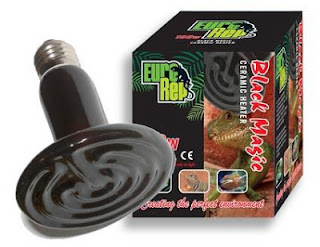I do not mean to be patronising when I say that heating is an
essential and extremely important part to keeping a reptile. As we all know, reptiles are cold
blooded so therefore cannot produce any body heat or regulate their temperatures
accordingly.
There are many different
ways to heat a tank but whether opting for a ceramic bulb, basking bulb or
heat mat, a thermometer is essential to ensure that the temperature is correct.
I would also recommend researching what housing and heating methods is best
suited for an animal. I sadly do not own any lizards but understand that they
need a UV bulb (in order for lizard’s growth and to strengthen their bones by
emitting vitamin D) and basking light so they have different needs than snakes.
Heat mats are placed in one side of the tank under the
bedding to provide the snake with a hot spot or basking spot. Depending on your
tank type, it can be important to position the heat mat on the outside of the
tank to prevent the animal from burning itself if the mat becomes too warm.
This is common for plastic and glass vivs but for a wooden viv, the heat mat
needs to be inside the tank but protected by perspex or similar material as
wood is not a good heat conductor. It is also a good idea to use a thermostat
or rheostat to gain a correct temperature reading. The thermostat should be
placed above the heat mat in order to correctly read the hot spot temperature.
 |
| Heat mat |
Radiant heat panels are similar to heat mats but give
off more heat as they come in higher wattage. Instead of placing them on the
floor of a vivarium they have been designed to fit at the back wall. They make
a good choice for snakes as they are for non-basking animals and are suited to
maintain high humidity and should be controlled through a thermostat. Therefore
could be fitted to the back of a rack system.
 |
| Heat panel |
Bulbs are often used to provide a hot spot for some breeds of
reptile and should be kept on a timer for 8-12 hours since they can dry out the
humidity in a cage therefore this type of heating will need to be in use in
conjunction with a heat mat when the bulb is turned OFF. Although ceramic bulbs
are better for snakes than basking bulbs because they do not have to be on a
timer and do not admit daylight they have been designed to be more effective
than most other reptile heat lamps and do not take away any humidity. Like heat
mats, bulbs need to be positioned on one side of the tank so the animal has
both a cold and warm side. Bulbs also needed to be fitted with a safe guard, to
ensure that the animal does not burn itself on the direct bulb. Generally
speaking, a heat mat is preferred for light body snakes like corn snakes and a
ceramic bulb is preferred for heavier bodied snakes such as pythons and boas.
 |
| Ceramic bulb |
I myself heat my snake tanks using a heat mat with
microclimate. Blaze’s tank is heated to 33◦C and the corn snakes to 32◦C. inside their tanks, I have placed a digital thermometer
with a humidity reader to ensure everything is as it should be. I have had
problems with my snakes shedding due to low humidity so I ensure that I
increase this when the snakes are in shed.
 |
| Thermostat |
I can’t stress enough for everyone to conduct research into
what needs their reptiles have. It is vital
to have the temperature correct. Leopard geckos for example need a
temperature that does not exceed 38◦C. Also ensure that you are getting
the correct housing and equipment as some reptile may need a UV tube light on a
timing system, this is common with
lizards. The Internet is a good source for research as are books, reptile forums and pet shops.
 |
| Leopard gecko |
No comments:
Post a Comment
Please leave a comment.